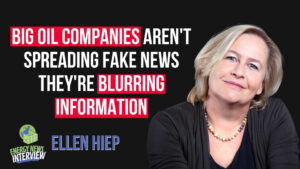Oil companies don’t fight EVs with technology—they fight with confusion
Ellen Hiep sits in theaters and hears people spreading lies about electric vehicles. She wants to interrupt them. She doesn’t. The misinformation spreads. As head of the Dutch Electric Vehicle Drivers Association (20,000 members) and Global EV Alliance steering committee member (60+ countries), Ellen has learned something critical: The biggest obstacle to EV adoption isn’t technology. It’s the billion-dollar misinformation machine.
WATCH THE FULL INTERVIEW
The Sophisticated Playbook
“Big OEMs, big oil companies—they’re not always spreading really bad fake news,” Ellen explains. “It’s about blurring information. Always asking questions so individuals don’t know where to listen.”
The strategy is elegant: Don’t lie. Just create enough doubt that people freeze at the dealership. Question battery safety. Worry about range. Suggest raw material concerns. Each delayed purchase funds the industries fighting the transition.
Ellen’s association created a “Facts and Fables” booklet for EV ambassadors who get cornered at birthday parties. “You need a response because otherwise it spreads around.”
The exhausting reality? “You have to debunk it constantly. Again and again and again.”
The Used Car Crisis
Here’s a problem that should terrify policymakers: Most secondhand EVs in the Netherlands are being exported.
The Dutch government subsidized company car purchases to flood the market with new EVs. In 4-5 years, affordable used EVs should have followed. Instead, they’re going abroad where other markets pay more.
“The critical period is 5 to 10 years,” Ellen says. “They’re leased by companies for the first five years, then they come into the market and immediately go abroad.”
Ellen’s association almost secured government support for the “E-Timer” scheme to keep used EVs in-country. “We almost had the deal done, but then the government collapsed. Now we have to do the whole work again.”
The Grid Solution in Your Driveway
The Netherlands went from celebrating individual charging points with “plug-in parties” (karaoke sets, barbecues) to building 200,000 chargers. Success created a new problem: grid congestion.
The solution? “We’re focusing on V2X—vehicle to everything,” Ellen explains. “What can you do with a battery? Store energy. Use it for your home. But also to elevate the grid.”
Her SCALE study across seven European countries revealed three barriers:
- Battery warranty fears
- Need for financial incentives (“People don’t do it for green energy. They do it because they earn money.”)
- Missing human research (“Most research is technical. There should be more on how people behave.”)
Mature markets show trust: “Model S Teslas from 2012 still have batteries at 90-92%.”
But V2G faces regulatory nightmares. The car, energy contract, and charging point must be “in one hand. Otherwise, it’s not working.” Plus unsolved tax questions: “If you charge at work for free, then use that energy for cooking at home, how does that work?”
Trust Beats Control
Ellen discovered something counterintuitive about smart charging: “Organizations say drivers want cutoff controls. But most EV drivers don’t use that after they trust the system.”
People don’t want control. They want certainty.
Her own dynamic energy contract: “At the beginning, I was checking—does it do what it says? After a while, you trust it and leave it.”
The Only Voice That Matters
On battery fears: “I don’t want to hear from people who sell the car that the battery is okay. I want to hear from my neighbor who uses it. Then I know I can trust it.”
This is why peer-to-peer validation beats manufacturer marketing every time.
The Fire Panic
“Having an EV on fire—there’s always panic. But most EVs are less likely to catch fire than gasoline cars.”
The data is clear. But emotional stories override statistics. “You have to debunk it constantly.”
When “Hype Is Fading”
While headlines scream about declining interest, reality tells a different story: 2.1 million EVs sold globally in one month. The best month ever.
“There’s a difference between what you see and what’s happening,” Ellen says. “EVs are booming. The cars are cheaper, cleaner, and going to get cheaper. They drive better.”
The Regulation Gap
Ellen’s been driving her Model 3 for six years. “Every update gives me a new car. It’s driving like the first day.”
But are software updates guaranteed long-term? “It’s a good question. I don’t know if there’s a regulation guaranteeing it.”
You’re spending €30,000+ on a computer with wheels with no guarantee of software support beyond five years. This needs regulation now.
The 10-Year Vision
“I want my car to be part of my home energy management system. Charge with solar panels, contribute to grid stability, and just whistle as I drive silently to work.”
The technology exists. The first bidirectional city in the Netherlands proves it. Scaling requires defeating misinformation, building regulatory frameworks, and coordinating stakeholders.
The Real War
Through the Global EV Alliance, Ellen coordinates with associations from Norway (90 employees, nearly electrified) to volunteer-run groups just starting. 80% volunteers, meeting monthly online.
The pattern is universal: “Every association goes through the same phase. Crazy volunteers spend their time on electrification.”
The constraint is always money for the hard work: publishing articles, local initiatives, and talking to governments.
Next time someone spreads misinformation about EVs, don’t stay polite like Ellen does. Interrupt them.
Because every unchallenged lie spreads. Every delayed purchase funds the industries fighting progress.
You’re not just answering a question. You’re fighting a war most people don’t know is happening.
And the other side is counting on your silence.

